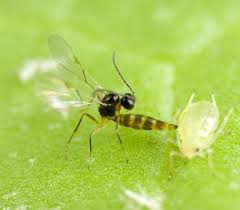Colemani Aphidius colemani
Aphidius colemani (Aphidius) will parasitise many aphid species including the green peach aphid (Myzus persicae) and the cotton or melon aphid (Aphis gossypii).
Description and biology
Aphidius are about 2-3mm long and black with brown legs. They look very similar to a small black ant with wings, but the antennae are long and slender. The parasite deposits an egg into the aphid in a matter of seconds. The aphid continues to move and feed for 3 days after the egg has been deposited. When the egg hatches, the Aphidius larva begins feeding on the aphid, eventually killing it. The parasitoid develops within the aphid body which at this stage is called a "mummy". The mummy looks like an over inflated bronze aphid. The Aphidius chews a hole through the back of the mummy and emerges as an adult wasp ready to deposit eggs in live aphids. Complete development time is temperature dependent, but is about 12 days at 25°C. This is longer than the development time of aphids, but each Aphidius female can parasitise over 300 aphids in her lifetime which can last 2-3 weeks when food and water are available.
Suitable crops
Aphidius can be used in all crops where susceptible aphids are pests. Aphidius is primarily used in greenhouse production, but can also be used in outdoor crops to get the parasitoids started earlier than would occur naturally. Crops that benefit from Aphidius include capsicums, eggplants (aubergine), cucumbers, flowers, a range of ornamentals, and some field crops such as cotton, melons, potato, brassicas and sweetcorn.
When to release
Aphidius works best when used preventatively, or when aphids are first noticed in a crop. This parasitoid is very good at dispersing and finding low populations of aphids. If aphid numbers are already high it is advisable to use a non-disruptive insecticide to lower the aphid population prior to release. Residual broad spectrum insecticides should not be used for at least four weeks prior to the release of Aphidius. Where several aphid species are present, release in conjunction with Aphidius ervi and Aphelinus abdominalis.
How to release
Aphidius are sent as aphid mummies in a small vial. Each vial contains approximately 500 mummies. When they arrive some adults may have emerged. Open the vial in the crop where they are to be released. Place the vial underneath the canopy of the crop and allow the adults to fly out of the vial. The remainder of mummies in the vial should be spread throughout the treated area by sprinkling them onto the foliage in several locations per vial, particularly in areas where aphids are known to be present.
Release rates
Rates will vary depending on the species of aphid targeted and the level of infestation at the time of release. The following rates have been determined overseas for the control of M. persicae and A. gossypii in greenhouse vegetables and can be used as a guide.
Preventative: 0.15/m2 weekly
After aphid detection: 0.5-1/m2/week for at least 3 weeks. Return to preventative rate once control is achieved.
Storage
Aphidius should be released as soon as possible after they are received. If they cannot be put into the crop immediately they can be stored at 8-12°C for a few days.
Chemical use
Aphidius is sensitive to many pesticides, particularly pyrethroids, organophosphates and neonicotinoids. Residues on foliage and greenhouse structures may remain toxic for many weeks and negatively impact on their survival and ability to effect control. Check side-effects charts carefully and avoid using pesticides before and during Aphidius use unless they are known to be safe. Contact Biological Services for specific information.
Ordering and accounts
Orders are sent via express courier on Monday or Tuesday of each week, and usually arrive within a couple of days. Orders received after noon on Tuesday are sent the following Monday. Prices are on a sliding scale i.e. the more that is purchased over a monthly period, the less the price will be per unit. Freight is charged at cost.
Accounts are sent at the end of each month, and can be paid by EFT, BPay, cheque or postal order.

Related pests
Related crops
- Cotton
- Flowers/ornamentals
- Greenhouse cucumbers
- Melons
- Nursery
- Sweetcorn







